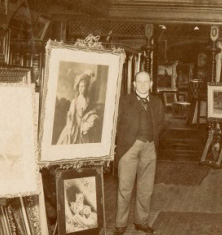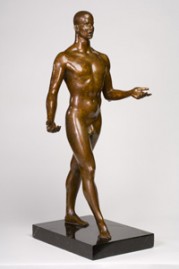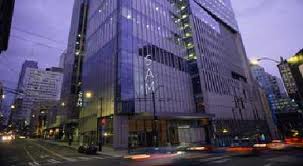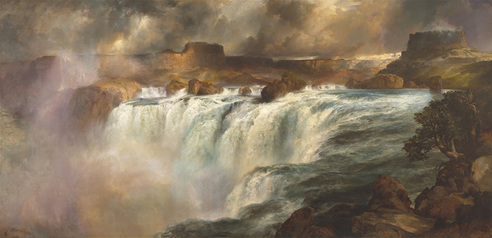Another history lesson (these coincidences happen).
Now the year is 1885: the first successful appendectomy is performed, the Madhi Muhammad Ahmad’s troops defeat Gordon and conquer Khartoum, the Washington Monument is dedicated, The Mikado opens at the Savoy Theatre, Good Housekeeping makes its debut, the Statue of Liberty arrives in New York Harbor.
 And Kraushaar Galleries is founded by Charles Kraushaar. Kraushaar, now located on East 79th Street and open “by appointment or by chance,” specializes in American art of the first half of the 20th century, and shares this longevity (to the 19th Century) with only three other New York galleries. They are Knoedler (dating to 1846), Babcock Galleries (1852) and James Graham & Sons (1857). Like Kraushaar, the later two specialize in American paintings.
And Kraushaar Galleries is founded by Charles Kraushaar. Kraushaar, now located on East 79th Street and open “by appointment or by chance,” specializes in American art of the first half of the 20th century, and shares this longevity (to the 19th Century) with only three other New York galleries. They are Knoedler (dating to 1846), Babcock Galleries (1852) and James Graham & Sons (1857). Like Kraushaar, the later two specialize in American paintings.
Kraushaar started out as a supply store, then handled many European artists. Under Charles’s brother, John, it became known for handling painters like Guy Pene du Bois, Charles Demuth, and several members of the group of American realists known as “the Eight,” most notably George Luks, William Glackens, Maurice Prendergast and John Sloan.
Kraushaar is marking the occasion with a book, Kraushaar Galleries: Celebrating 125 Years, by Betsy Fahlman, and an exhibition with the same title at the New York Research Center of the Archives of American Art curated by Fahlman. The Archives, happily, owns the galleries’ records from 1885 through 1968 (the findings aids are here).
Other galleries, please note: the galleries’ records were donated.
The book is out tomorrow, and the exhibition begins on Wednesday. It will consist of 48 photographs and documents drawn from that trove. That’s presumably an image of the gallery above (it’s copied from the exhibition announcement).
I remember first visiting Kraushaar when Charles’s niece/John’s daughter Antoinette Kraushaar was in charge, and the location was 724 Fifth Avenue. She had started working at the gallery in 1917, at age 15, took it over in 1946 upon her father’s deaths, and remained at the helm until 1988. She died in 1992. Carole Pesner and Katherine Degn now run the gallery.
A formidable dealer who helped found the Art Dealers Association of America, Antoinette was an oral history subject of the Archives (a transcript is here), interviewed four times by Avis Berman in 1982. In 1917, Luks painted a lovely portrait of her, in her grammar school graduation dress, that’s now owned by the Brooklyn Museum. Have a look.
She later recalled:
It was very interesting because you could see how he would put a strong stroke in the painting–I couldn’t see the painting, but I could see him as he worked on it. At one point he said there was an awful lot of white, so he went around the studio and came up with a dusty piece of blue linen that he draped over my shoulder.
There’s a lot of history here, worth plumbing — because learning about galleries inevitably means learning about artists. More information here.
Photo Credit: Courtesy Archives of American Art

 And the Museum of Modern Art — which had opened its doors six years earlier — is ready to mount its first retrospective for any living American artist.
And the Museum of Modern Art — which had opened its doors six years earlier — is ready to mount its first retrospective for any living American artist. SAM is in a precarious position in part because it allied itself with the defunct Washington Mutual bank, a casualty of the mortgage lending debacle. WaMu had leased eight floors in SAM’s new 16-story building, and then it died, leaving SAM without a tenant. Chase Bank, which bought WaMu, gave the museum $10 million, and some of the space intended for WaMu has been leased, but SAM is still out several million dollars.
SAM is in a precarious position in part because it allied itself with the defunct Washington Mutual bank, a casualty of the mortgage lending debacle. WaMu had leased eight floors in SAM’s new 16-story building, and then it died, leaving SAM without a tenant. Chase Bank, which bought WaMu, gave the museum $10 million, and some of the space intended for WaMu has been leased, but SAM is still out several million dollars. He showed up for his first day of work yesterday, and — journalists being journalists — the Kansas City Star last Friday published an
He showed up for his first day of work yesterday, and — journalists being journalists — the Kansas City Star last Friday published an 